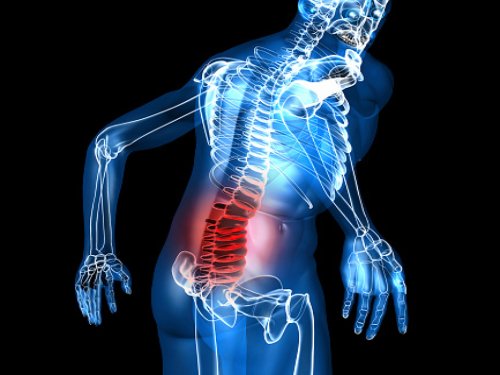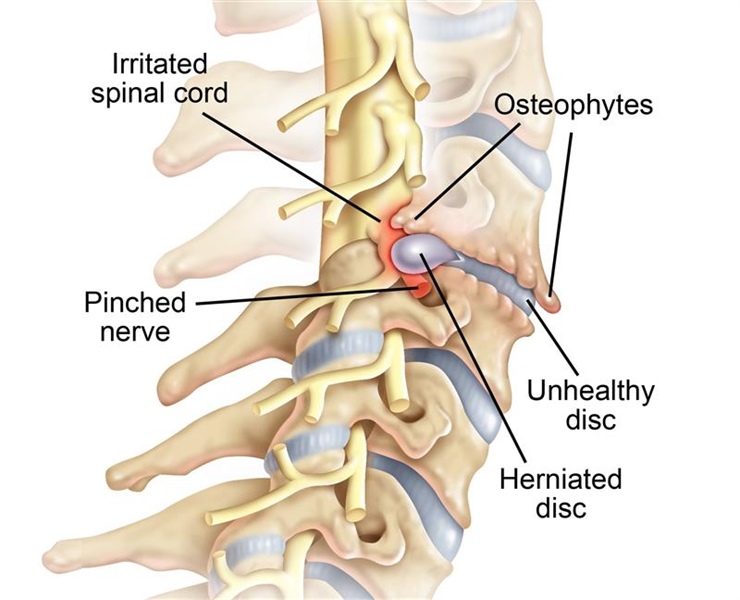
Radiculitis is a medical condition associated with inflammation or compression of the nerve roots located in the spinal canal. These nerve roots are responsible for transmitting signals from the central nervous system to various parts of the body. In the case of radiculitis, for various reasons - most commonly due to intervertebral disc herniation, spinal stenosis, arthritis, or trauma - these nerve roots become irritated or compressed, causing characteristic symptoms.
Causes of radiculitis
Radiculitis, medically known as radiculopathy, is a condition that occurs due to compression, inflammation, or damage to one or several nerve roots in the spinal area. These nerve roots are responsible for transmitting signals between the brain and peripheral nerves, so their impairment can cause pain, weakness, loss of sensation, or other neurological symptoms, depending on the location of the affected root.
The causes of radiculitis are varied and are usually associated with structural changes in the spine affecting the nerve roots. The main causes include:
- Intervertebral disc herniation: When the nucleus of a spinal disc protrudes through the fibrous ring, it can compress the adjacent nerve roots. This condition is the most common cause of radiculitis.
- Degenerative spinal changes: Aging can lead to disc dehydration, loss of disc height, and formation of osteophytes (bone spurs). These changes can narrow the nerve root canals and cause their compression.
- Spondylolisthesis: This is a condition where one vertebra slips backward or forward over another, which can eventually compress the nerve roots.
- Spinal stenosis: Narrowing of the spinal canal, most often due to osteoarthritis or other degenerative changes, can compress the spinal nerve root canals.
- Inflammation or infection: Less common causes may include infectious or inflammatory conditions such as spondyloarthropathy or meningitis, which can also affect the nerve roots.
- Trauma: Physical injury, such as a back impact or improper lifting, can also cause damage to the nerve roots.
The diagnosis and treatment of radiculitis depend on the specific cause and the patient's symptoms. It is important that the treatment is carried out by qualified healthcare professionals who can perform proper diagnostics, assess symptoms, and develop an individualized treatment plan.
Symptoms caused by radiculitis
Radiculitis can manifest in various symptoms, depending on the location of the affected nerve root and its innervated area.
The most common symptom of radiculitis is pain, which can be localized directly at the affected nerve root or spread to other body parts. For example, if the nerve root in the back is affected, the pain can radiate into the leg. The pain is often sharp, burning, and can intensify with certain movements or changes in posture.
Patients may experience tingling, numbness, or loss of sensation in the affected area. These sensations can be constant or only appear in certain positions.
Compression of the nerve root can cause muscle weakness in the innervated area. For example, if a nerve innervating the leg muscle is affected, it can be difficult to perform certain movements, such as standing on tiptoes.
There may be a decrease or loss of reflexes in the affected area. This is a neurological sign that can be detected by a doctor during a physical examination.
Symptoms can change depending on the body's position. Some patients may notice relief of symptoms when changing posture or lying down.
In severe cases, there can be significant loss of function in the affected area, such as difficulty performing daily activities due to pain or weakness.
Radiculitis symptoms can vary depending on which part of the spine is affected. For example, if the damage is in the neck area, symptoms can manifest in the arms, while in the lumbar region - in the legs.

How to distinguish radiculitis symptoms from other back pains?
Distinguishing radiculitis symptoms from other back pains can be challenging, as many spinal conditions can present similar signs. Radiculitis, or compression of the nerve roots in the spinal area, causes specific symptoms that differ from general back pains or other spinal disorders.
- Nature and spread of pain. The pain caused by radiculitis is often sharp, burning, and typically radiates from the back to other body parts corresponding to the innervation area of the affected nerve root. For instance, lumbar radiculitis can cause pain that radiates into the legs. In contrast, typical back pains are usually localized, and their intensity can vary from mild to severe, but they generally do not radiate to other body parts.
- Sensory changes. In the case of radiculitis, there may be tingling, numbness, or loss of sensation in the affected area. These symptoms indicate nerve function impairment, which is less characteristic of typical back pains.
- Movement restriction and posture. While general back pains can limit movement due to pain or muscle tension, in the case of radiculitis, patients may notice that certain positions or movements, such as bending or twisting the body, can significantly increase pain or cause sensations similar to an 'electric shock'.
- Muscle weakness. Radiculitis can cause clear muscle weakness in the affected area. For example, if the nerve root controlling leg muscles is affected, there can be leg weakness or even difficulties in performing simple activities, such as walking.
- Reflex changes. A doctor can detect a decrease or loss of reflexes in the affected area, which is typical of radiculitis.
Treatment methods
The treatment of radiculitis is individualized and depends on the severity of symptoms, the location of the injury, and the patient's overall health condition. The main goal of treatment is to alleviate pain, reduce inflammation of the nerve roots, and restore normal nerve function. Various treatment methods include conservative measures, pharmacological treatment, and, in rare cases, surgical intervention.
Conservative treatment
Individualized exercise plans are designed to strengthen the back and abdominal muscles, improve spinal flexibility, and reduce tension in the nerve roots. Special exercises that help reduce pressure in the affected areas can also be used. Chiropractic, osteopathy, or manual therapy sessions can also help restore normal spinal movement, reduce compression, and improve nerve function. Heat and cold therapies can also be used for pain relief and inflammation reduction.
Pharmacological treatment
Non-steroidal anti-inflammatory drugs (e.g., ibuprofen or naproxen, used for pain and inflammation control), muscle relaxants, antineuropathic drugs (e.g., gabapentin or pregabalin, especially effective when there is nerve-induced pain), corticosteroid injections.
Surgical treatment
This is reserved for severe cases of compression or when conservative treatment is ineffective.
Alternative therapies
Acupuncture, yoga exercises, and meditation can also help reduce pain and improve the patient's overall well-being.
It is important to note that the radiculitis treatment plan should be developed considering the patient's individual needs, the course of the disease, and possible contraindications to certain therapies. Moreover, regular assessment of the patient's condition and, if necessary, adjustment of the treatment plan is important.
Preventive measures
Preventive measures are mostly related to general health and lifestyle aspects that help reduce spinal load and strengthen its structures.
- Proper physical condition. Regular and balanced physical activity, including exercises to strengthen the back and abdominal muscles, is important for spinal health. This helps maintain muscle balance and reduces pressure on spinal discs and nerve roots.
- Healthy posture. Maintaining correct posture while sitting and performing daily activities is important. Improper posture can increase spinal load and encourage degenerative processes.
- Weight control. Overweight or obesity increases pressure on the spine, so a healthy weight is important for the prevention of radiculitis.
- Ergonomic workplace. It is important to ensure that the workplace is adapted to the individual, especially if a lot of time is spent in a seated position. Ergonomic settings of chairs, desks, and computer equipment can reduce back tension.
- Quitting smoking. Smoking not only worsens overall health but can also negatively affect spinal discs, promoting degenerative changes.
Prognosis
The prognosis for radiculitis is usually favorable, especially when treatment is started timely and properly administered. In many cases, symptoms can be effectively controlled or completely disappear with conservative treatment, including medication, physiotherapy, and exercise.
However, the prognosis may vary depending on the cause of radiculitis, its severity, and the patient's overall health condition. In more severe cases, where there is intense pain or other complications, more intensive treatment methods, including surgical intervention, may be required.
It is important to emphasize that regular monitoring of health status and adherence to the doctor's recommendations are necessary to achieve the best treatment results and avoid potential complications. Patient education on proper posture, weight control, and physical activity are important aspects that help maintain spinal health and reduce the risk of recurrence of radiculitis.
Sources of information:
- World Health Organization (WHO)
- Centers for Disease Control and Prevention (CDC)
# radikulitas

